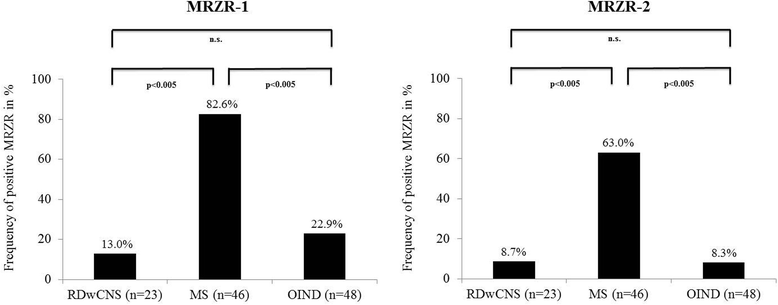The MRZ reaction helps to distinguish rheumatologic disorders with central nervous involvement from multiple sclerosis
- PMID: 29386006
- PMCID: PMC5793342
- DOI: 10.1186/s12883-018-1018-3
The MRZ reaction helps to distinguish rheumatologic disorders with central nervous involvement from multiple sclerosis
Abstract
Background: Some rheumatologic disorders may initially manifest with central nervous system (CNS) affection, mimicking the clinical, magnetic resonance imaging, and cerebrospinal fluid findings of multiple sclerosis (MS). The MRZ reaction (MRZR), composed of the three respective antibody indices (AIs) against measles, rubella, and varicella zoster virus, has been found positive frequently in MS patients. However, it is unclear whether the MRZR is helpful to distinguish rheumatologic disorders with CNS involvement (RDwCNS) from MS.
Methods: The MRZR was evaluated in patients with RDwCNS (n = 23), MS (n = 46; age and sex matched to patients with RDwCNS), and other inflammatory autoimmune neurological diseases affecting the CNS (OIND; n = 48). Both the stringency levels that have been used in previous MRZR studies, MRZR-1 (≥ 1 of 3 AIs positive) and MRZR-2 (≥ 2 of 3 AIs positive), were applied.
Results: There was no statistically significant difference in the prevalence of positive MRZR between patients with RDwCNS (MRZR-1: 13.0% and MRZR-2: 8.7%, respectively) and OIND (MRZR-1: 22.9% and MRZR-2: 8.3%, respectively). Compared to these two study cohorts, the MS group exhibited significantly higher prevalences of positive MRZR (MRZR-1: 82.6%, MRZR-2: 63.0%; p < 0.005 each).
Conclusions: Considering the high specificity of MRZR-2 for MS found in this study, MRZR-2 can be a useful diagnostic tool for distinguishing MS from RDwCNS or OIND.
Keywords: ANCA-associated vasculitides; Behçet’s disease; Intrathecal polyspecific antiviral immune response; MRZ reaction (MRZR); Multiple sclerosis (MS); Neuropsychiatric systemic lupus erythematosus (NPSLE).
Conflict of interest statement
Authors’ information
All authors are physicians working at the Medical Center - University Freiburg, Germany. TH, RD, DE and US are resident physicians; BB is a consultant physician. DH is a senior physician at the Institute of Virology. SR is the chief physician at the Department of Neurology and Neurophysiology. OS is a senior physician at the Department of Neurology and Neurophysiology. JT and NV are senior physicians at the Department of Rheumatology and Clinical Immunology.
Consent for publication
Not applicable.
Competing interests
TH received travel grants from Bayer Vital GmbH and Novartis. RD, DE, and US report no conflicts of interest for this study. BB received travel grants and/or training expenses from Bayer Vital GmbH, Ipsen Pharma GmbH, Norvartis, and Genzyme, as well as lecture fees from Ipsen Pharma GmbH. DH received lecture fees from Serion. OS and SR report receiving consulting and lecture fees, grant, and research support from Baxter, Bayer Vital GmbH, Biogen Idec, Genzyme, Merck Serono, Novartis, RG, Sanofi-Aventis, and Teva. SR indicates that he is a founding executive board member of ravo Diagnostika GmbH (Oltmannsstrasse 5, D-79100 Freiburg, Germany), which sells in-vitro diagnostic medical devices for the detection of infectious diseases and paraneoplastic autoantibodies. JT and NV have served on the advisory boards of, have participated in lectures for, and/or received research or travel grants from AbbVie, GSK, Janssen-Cilag, Lilly, Medac, Novartis, Pfizer, and Roche.
Publisher’s Note
Springer Nature remains neutral with regard to jurisdictional claims in published maps and institutional affiliations.
Figures
Similar articles
-
The MRZ-Reaction and Specific Autoantibody Detection for Differentiation of ANA-Positive Multiple Sclerosis From Rheumatic Diseases With Cerebral Involvement.Front Immunol. 2019 Mar 19;10:514. doi: 10.3389/fimmu.2019.00514. eCollection 2019. Front Immunol. 2019. PMID: 30941143 Free PMC article.
-
The MRZ reaction as a highly specific marker of multiple sclerosis: re-evaluation and structured review of the literature.J Neurol. 2017 Mar;264(3):453-466. doi: 10.1007/s00415-016-8360-4. Epub 2016 Dec 22. J Neurol. 2017. PMID: 28005176 Review.
-
The MRZ reaction in primary progressive multiple sclerosis.Fluids Barriers CNS. 2017 Feb 7;14(1):2. doi: 10.1186/s12987-016-0049-7. Fluids Barriers CNS. 2017. PMID: 28166789 Free PMC article.
-
The MRZ reaction and a quantitative intrathecal IgG synthesis may be helpful to differentiate between primary central nervous system lymphoma and multiple sclerosis.J Neurol. 2018 May;265(5):1106-1114. doi: 10.1007/s00415-018-8779-x. Epub 2018 Mar 6. J Neurol. 2018. PMID: 29511863
-
Low intrathecal antibody production despite high seroprevalence of Epstein-Barr virus in multiple sclerosis: a review of the literature.J Neurol. 2018 Feb;265(2):239-252. doi: 10.1007/s00415-017-8656-z. Epub 2017 Nov 2. J Neurol. 2018. PMID: 29098417 Review.
Cited by
-
Cerebral lesions sites in neurosarcoidosis: a lesion mapping study.J Neurol. 2023 Nov;270(11):5392-5397. doi: 10.1007/s00415-023-11863-3. Epub 2023 Jul 12. J Neurol. 2023. PMID: 37433894 Free PMC article.
-
The MRZ-Reaction and Specific Autoantibody Detection for Differentiation of ANA-Positive Multiple Sclerosis From Rheumatic Diseases With Cerebral Involvement.Front Immunol. 2019 Mar 19;10:514. doi: 10.3389/fimmu.2019.00514. eCollection 2019. Front Immunol. 2019. PMID: 30941143 Free PMC article.
-
Clinical associations and characteristics of the polyspecific intrathecal immune response in elderly patients with non-multiple sclerosis chronic autoimmune-inflammatory neurological diseases - a retrospective cross-sectional study.Front Neurol. 2023 Jun 15;14:1193015. doi: 10.3389/fneur.2023.1193015. eCollection 2023. Front Neurol. 2023. PMID: 37396770 Free PMC article.
-
[Neuroimmunology and rheumatology: overlap and differential diagnoses].Nervenarzt. 2018 Oct;89(10):1095-1105. doi: 10.1007/s00115-018-0597-y. Nervenarzt. 2018. PMID: 30215132 Review. German.
References
-
- Asakura K, Muto T. Neurological involvement in Wegener's granulomatosis. Brain Nerve. 2013;65:1311–1317. - PubMed
MeSH terms
Substances
LinkOut - more resources
Full Text Sources
Other Literature Sources
Medical


